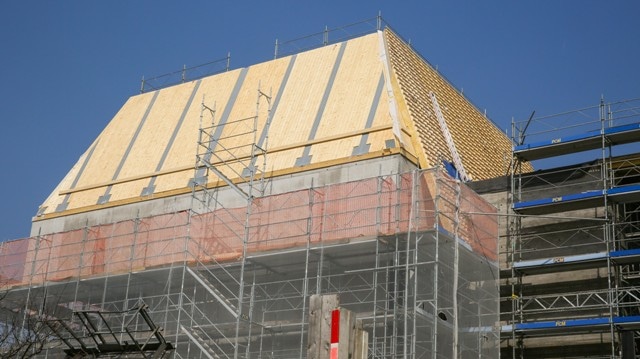Apr 4 2016
All wood, no beams: the cantonal parliament in Lausanne, which is currently being rehabilitated, will be roofed using new wood construction technology researched and developed at EPFL.
 © 2016 EPFL – Alain Herzog
© 2016 EPFL – Alain Herzog
It was a tall order: designing a rooftop for a 290-m2 parliamentary hall in the Vaud cantonal parliament, built atop 13th Century ruins, nested snuggly into the picturesque skyline of the old city of Lausanne.Located between the Château Sainte-Maire and the Lausanne Cathedral, the parliament hall, once inaugurated in 2017, will be endowed with a roof supported only by its base, a glazed atrium letting in natural light, and a gallery overlooking the conference arena for citizens and journalists. The novelty of the almost 15-meter tall roof lies in its beam-free design.
Yves Weinand is the director of EPFL’s Timber Construction Laboratory. But on the construction site in the historical center of Lausanne, he is the lead civil engineer. He represents his private civil engineering firm, which, together with a Lausanne and Barcelona based architectural practice, won the architectural competition for the renovation. Weinand is a staunch advocate of wooden architecture. “The wooden aspect of the framework strongly convinced the jury because of the direct connivance between the structure’s form and the functions that it will serve for the large parliament hall,” he explains.
Transferring technology from the lab to the city
The roof’s innovative design makes the structure remarkably robust, with little wasted space. Normally, wooden roofs are carried by a framework of beams. The most fragile points of these structures are located where the beams are connected. If one beam fails, the stability of the entire roof can be compromised. By working with large, preassembled wooden panels that make up both the structure’s surface and its load bearing elements, the proposal made by Weinand and his team distributes all forces along the entire surface of the roof, rather than concentrating it in specific locations.
The roof’s beamless design was made possible thanks to the development of cross-laminated timber panels, a major innovation in wood technology. By gluing wooden boards so that the directions of their fibers alternate from layer each layer, these panels provide high strength, even for very thin panels. But without years of research into how these wooden panels distribute the loads they carry, conducted at Weinand’s research group at EPFL, he says that he may not have won the mandate with a beam-free roof of these dimensions. “Proposals based on technological innovations rarely receive public mandates, because of the risks associated with them. The fact that we had extensive research to back our claims definitely played in our favor,” he says.
Competing with prefabricated concrete elements
According to Weinand, working with prefabricated timber elements has many advantages, besides its low carbon footprint and appealing aesthetics. Structures can be designed in advance in a factory, rather than being cut on site. All of the pieces arrive on the construction site numbered and labeled, with only one single position for each piece, leaving less room for mistakes and greatly speeding up the construction process. “With the building’s inauguration planned for 2017, we are happy to see the wooden portion of the renovation take shape in a matter of weeks, not years,” says Weinand.
Over time, he would like to see his approach evolve to the point that bespoke and digitally controlled prefabricated bearing elements will present solutions for large structures designed and produced entirely out of wood. “We received this mandate in 2009. Had we received it today, we may have already been able to propose a design that does away entirely with the metal connectors used to hold the structure together,” he says. With the increasing emphasis on sustainability of built structures, both during their assembly, and during their disassembly, it’s the direction that Weinand and his team at iBois believe the field should move in.